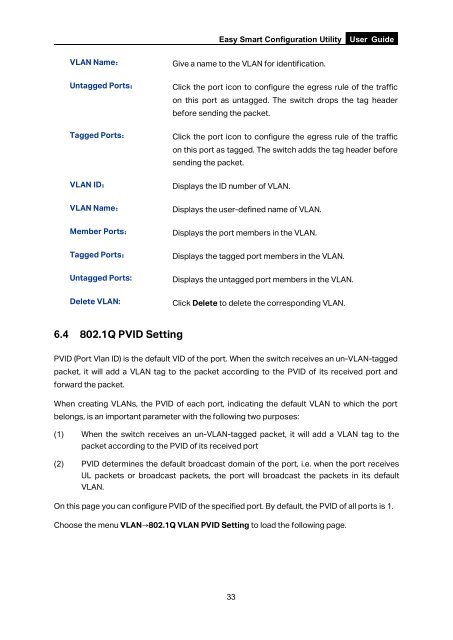Easy_Smart_Configuration_Utility_UG_1478226831098y
Easy Smart Configuration Utility User Guide VLAN Name: Give a name to the VLAN for identification. Untagged Ports: Click the port icon to configure the egress rule of the traffic on this port as untagged. The switch drops the tag header before sending the packet. Tagged Ports: Click the port icon to configure the egress rule of the traffic on this port as tagged. The switch adds the tag header before sending the packet. VLAN ID: Displays the ID number of VLAN. VLAN Name: Displays the user-defined name of VLAN. Member Ports: Displays the port members in the VLAN. Tagged Ports: Displays the tagged port members in the VLAN. Untagged Ports: Displays the untagged port members in the VLAN. Delete VLAN: Click Delete to delete the corresponding VLAN. 6.4 802.1Q PVID Setting PVID (Port Vlan ID) is the default VID of the port. When the switch receives an un-VLAN-tagged packet, it will add a VLAN tag to the packet according to the PVID of its received port and forward the packet. When creating VLANs, the PVID of each port, indicating the default VLAN to which the port belongs, is an important parameter with the following two purposes: (1) When the switch receives an un-VLAN-tagged packet, it will add a VLAN tag to the packet according to the PVID of its received port (2) PVID determines the default broadcast domain of the port, i.e. when the port receives UL packets or broadcast packets, the port will broadcast the packets in its default VLAN. On this page you can configure PVID of the specified port. By default, the PVID of all ports is 1. Choose the menu VLAN→802.1Q VLAN PVID Setting to load the following page. 33
Easy Smart Configuration Utility User Guide Figure 6-6 802.1Q VLAN PVID Setting The following entries are displayed on this screen: ‣ 802.1Q VLAN PVID Setting Select: Port: PVID: LAG: Select the desired port for configuration. It is multi-optional. Displays the port number. Enter a PVID number for the port. When adding the tag header to the received untagged packet, the switch will automatically uses this PVID value as the VLAN ID of the added tag. Displays the LAG to which the port belongs. Note: 1. 802.1Q VLAN should be enabled before setting PVID. 2. You can go to Switching→LAG page to configure the LAG status of the port. Return to CONTENTS 34
- Page 1 and 2: User Guide Easy Smart Configuration
- Page 3 and 4: Easy Smart Configuration Utility Us
- Page 5 and 6: Easy Smart Configuration Utility Us
- Page 7 and 8: Easy Smart Configuration Utility Us
- Page 9 and 10: Easy Smart Configuration Utility Us
- Page 11 and 12: Easy Smart Configuration Utility Us
- Page 13 and 14: Easy Smart Configuration Utility Us
- Page 15 and 16: Easy Smart Configuration Utility Us
- Page 17 and 18: Easy Smart Configuration Utility Us
- Page 19 and 20: Choose the menu System→User Accou
- Page 21 and 22: Easy Smart Configuration Utility Us
- Page 23 and 24: Easy Smart Configuration Utility Us
- Page 25 and 26: Easy Smart Configuration Utility Us
- Page 27 and 28: Easy Smart Configuration Utility Us
- Page 29 and 30: Easy Smart Configuration Utility Us
- Page 31 and 32: Easy Smart Configuration Utility Us
- Page 33 and 34: Easy Smart Configuration Utility Us
- Page 35: Easy Smart Configuration Utility Us
- Page 39 and 40: Easy Smart Configuration Utility Us
- Page 41 and 42: Easy Smart Configuration Utility Us
- Page 43 and 44: Easy Smart Configuration Utility Us
- Page 45: Easy Smart Configuration Utility Us
<strong>Easy</strong> <strong>Smart</strong> <strong>Configuration</strong> <strong>Utility</strong> User Guide<br />
VLAN Name:<br />
Give a name to the VLAN for identification.<br />
Untagged Ports:<br />
Click the port icon to configure the egress rule of the traffic<br />
on this port as untagged. The switch drops the tag header<br />
before sending the packet.<br />
Tagged Ports:<br />
Click the port icon to configure the egress rule of the traffic<br />
on this port as tagged. The switch adds the tag header before<br />
sending the packet.<br />
VLAN ID:<br />
Displays the ID number of VLAN.<br />
VLAN Name:<br />
Displays the user-defined name of VLAN.<br />
Member Ports:<br />
Displays the port members in the VLAN.<br />
Tagged Ports:<br />
Displays the tagged port members in the VLAN.<br />
Untagged Ports:<br />
Displays the untagged port members in the VLAN.<br />
Delete VLAN:<br />
Click Delete to delete the corresponding VLAN.<br />
6.4 802.1Q PVID Setting<br />
PVID (Port Vlan ID) is the default VID of the port. When the switch receives an un-VLAN-tagged<br />
packet, it will add a VLAN tag to the packet according to the PVID of its received port and<br />
forward the packet.<br />
When creating VLANs, the PVID of each port, indicating the default VLAN to which the port<br />
belongs, is an important parameter with the following two purposes:<br />
(1) When the switch receives an un-VLAN-tagged packet, it will add a VLAN tag to the<br />
packet according to the PVID of its received port<br />
(2) PVID determines the default broadcast domain of the port, i.e. when the port receives<br />
UL packets or broadcast packets, the port will broadcast the packets in its default<br />
VLAN.<br />
On this page you can configure PVID of the specified port. By default, the PVID of all ports is 1.<br />
Choose the menu VLAN→802.1Q VLAN PVID Setting to load the following page.<br />
33



